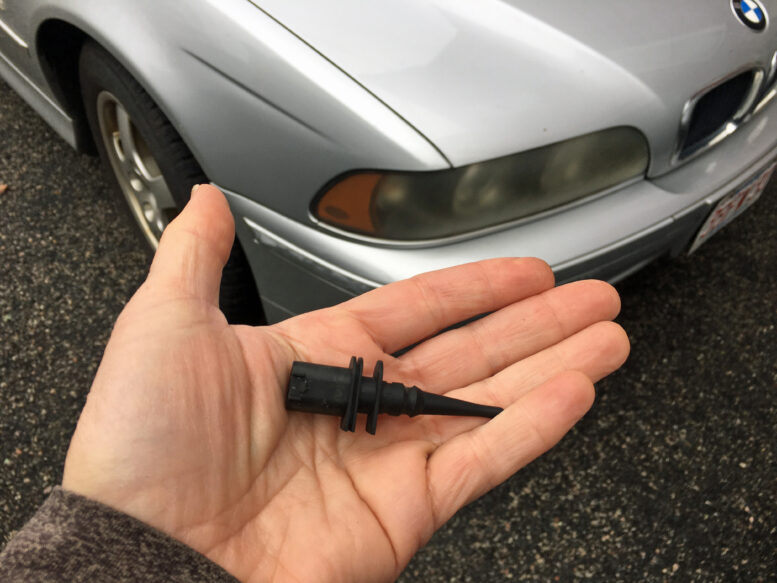Okay, I actually worked on a BMW this week. The media have been alerted.
My daily-driver 2003 E39 530i stick sport had a problem that, when driven in wet weather, the ambient temperature sensor located up under the right front fender malfunctions, reporting the lowest possible temperature of, I believe, -40°F. This has the undesirable effect of being interpreted by the climate control system as “Well, then there’s no possible reason for me to ever turn on the air conditioning, is there? In fact, you need heat, and lots of it.” I first noticed the problem a year and a half ago when I was driving down to Asbury Park NJ on an unseasonably warm but rainy November weekend. With the air conditioning disabled by the HAL-like “I’m afraid I can’t do that, Rob” climate control system, I had both a fogged-up windshield and a hot and humid cabin, and needed to keep a window partially open while blasting hot air at the windshield. When I got home from the trip, I ordered the sensor. It’s cheap, only about $17 for the Febi-Bilstein version of the part.
And then I forgot about it. I work from home and thus have literally zero commute, I don’t routinely take drives like the six hours each way to Asbury Park in the E39, and as long as the weather wasn’t both hot and rainy, it wasn’t a problem.
Fast-forward to a few weeks ago. It’s been a relatively warm and rainy winter here in Boston, and while running some routine errand in the rain in the E39, I found that the windshield kept fogging up, and trying to defog it resulted in a blast furnace-level of heat. I realized what was going on, and remembered that I’d already bought a replacement sensor. By coincidence, that evening I was scheduled to give a talk up in Nashua NH to the BMW CCA White Mountain Chapter, and rain was forecast for the evening. I resolved to fix the problem by installing the new sensor before I left. I had four hours, so I wasn’t at all concerned.
The first task was to find the replacement sensor I’d bought. When you order a part that you need immediately, you grab it when it arrives and carry it straight into the garage and install it, but if you’re like me, you get into trouble when a part arrives and don’t use it for months. There’s a path that this sort of stuff takes—the package gets opened up in the kitchen, goes into a carboard box with other automotive stuff destined for the basement, and then it can either languish there or can find its way into the garage. Once there, it may wind up in the trunk of the car it’s intended for (if the car is even in the garage), or be put in a car-specific box on the shelves, or wind up in a general box for new uninstalled parts. I searched all of these places multiple times and came up empty. I began to wonder if I my memory was correct that I’d purchased the sensor. I searched my Amazon and eBay purchase history and found nothing. Finally I found it in an order from FCP Euro along with rear wheel cylinders for the tii. Great, I thought; when the box arrived, I probably put it in the trunk of the tii, which is sitting in the warehouse in Monson. But another search of the basement unearthed the unopened box from FCP sitting on the step from the basement into the garage.

That was quite a game of hide and seek.
I backed the M Coupe out of the garage to make room for the E39, and drove the nose of the car onto the plastic ramps I use for quick under-engine things like oil changes. I’ve replaced these ambient temperature sensors in a number of cars over the years. It’s a Chapstick-sized plastic thing, shaped sort of like a cross between a dart, a syringe, and an ear-cleaning device. The sensor has a two-prong electrical connector at one end, and it snaps into a clip on a piece of the shrouding in the front right corner of the fender. I remembered that that clip had long since broken off on the E39, so I had the sensor zip-tied to the bracket of the auxiliary air pump. But still, replacing the sensor really should be about as trivial as a repair gets. It may have taken me an hour to find the damned thing, but I’d surely be done in five minutes.
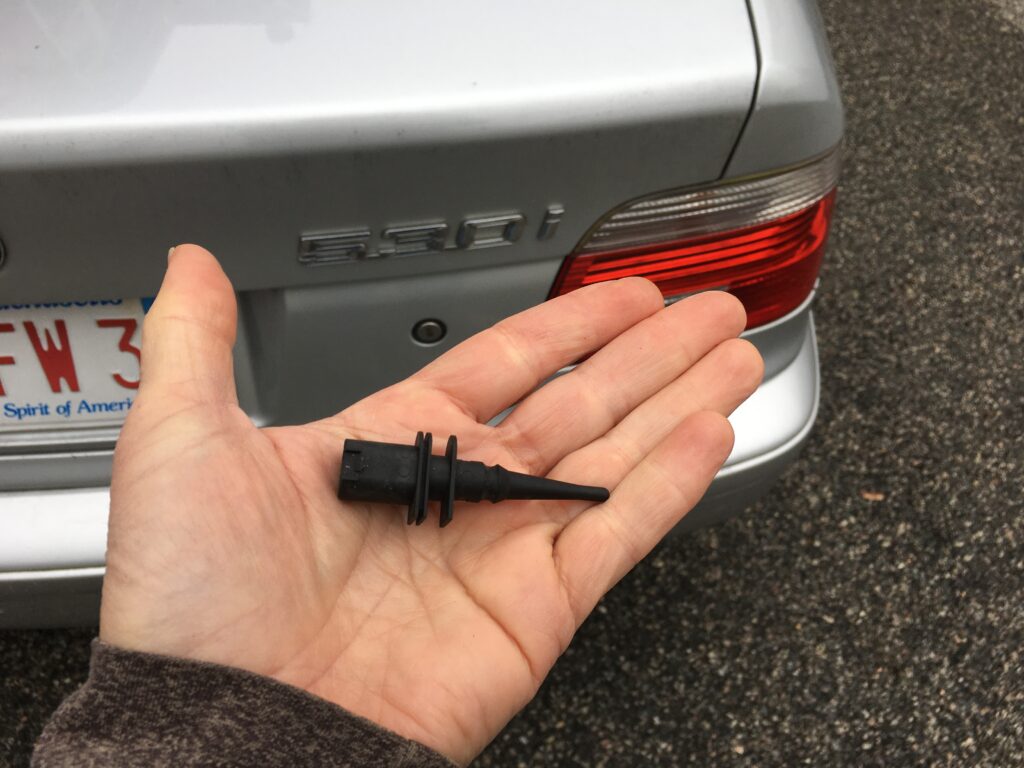
Temperature sensor or ear cleaner? You be the judge.
I crawled under the car and saw the existing zip-tied sensor, but unfortunately, I also saw that one of the wires leading to it was clearly broken. We can have a lengthy discussion about the whole “rhythm of repair” question (I have a chapter in my first book devoted to the issue of buying parts before you’ve actually delved into a detailed diagnosis of a problem), but it was a $17 sensor, so I’m not going to sweat the fact that, had I checked before ordering it, I would’ve seen that what I need to do was fix a broken wire, not swap the sensor.
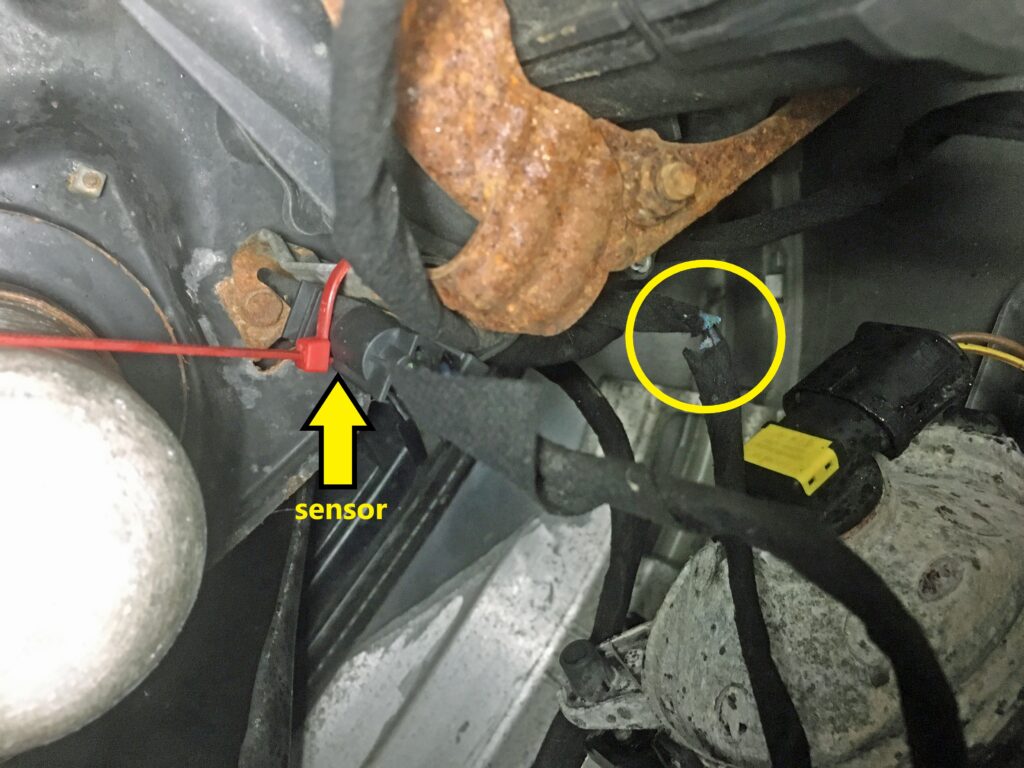
A-HA!
Still, this initially looked like a simple issue—I’d just need to splice the broken wire with either a crimp-on connector, a heat-shrink connector, or by manually soldering the wires (for more detail on these options, I described them last fall in a piece I wrote about repairing the broken wiring harness in the E39’s trunk lid). But when I unclipped the sensor and let it and the section of wiring harness down, I realized that I had a problem—the break was high enough up that I could only get one hand at a time on the wires. To spice wires together with any of the three methods mentioned above, you generally need to use both hands.
I looked carefully at the wires, and could see that the insulation on the second one was cracking as well, so I cut the pigtail off, allowing me to at least work on that end free of the cramped space in the corner of the fender.
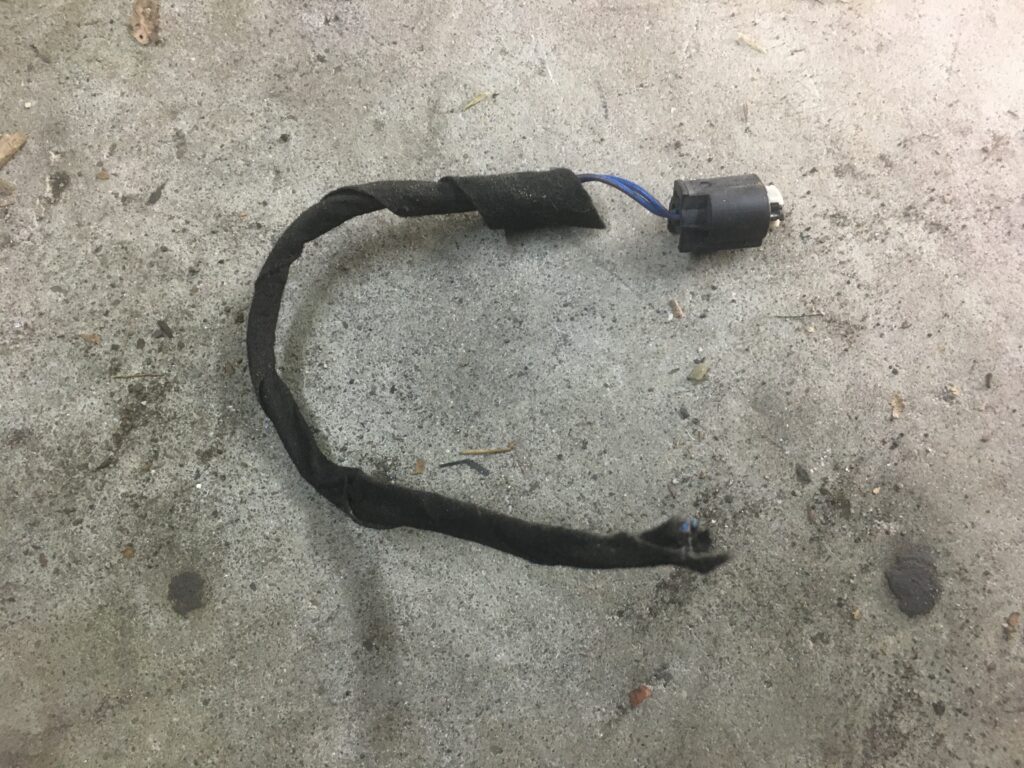
Out you come.
I then peeled back the cloth tape on the pigtail and stripped the ends of the wires. Obviously that was the easy part—I needed to do the same on the section in the car on which I could only lay one hand at a time. It eventually became clear that there was no real way to one-hand the repair. After looking at several options to increase my access, I found that if I removed the right-hand part of the grille and the right fog light, I could get two hands in there at the same time. I reached in and stripped the wire ends.
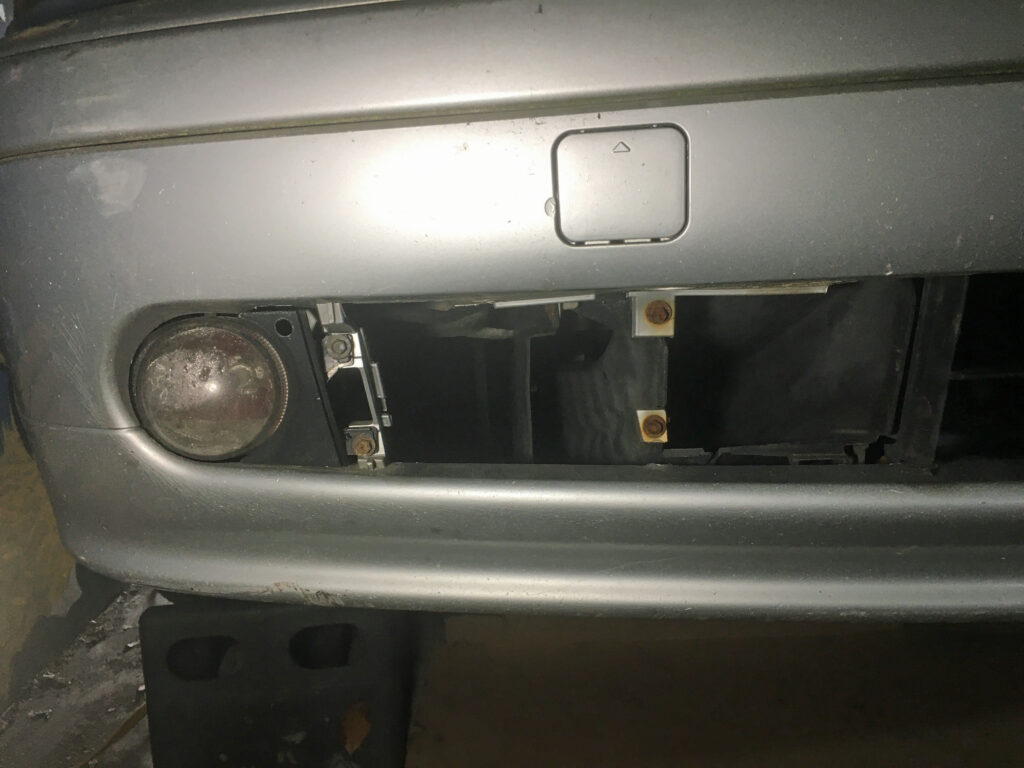
Removing a few push-in clips to pull out the right-hand grille…

…and two 7mm nuts to remove the fog light. Note the now-stripped wire ends for the temperature sensor.
For the actual repair, I used solder-melt heat-shrink splices. These are very handy, as you just need to strip both ends of the wire, insert them so they overlap inside the band of solder in the center of the splice, and heat it up with a heat gun. This both melts the solder band to electrically connect the wires as well as shrinks the tubing to make a weather-tight seal. Plus, getting the nose of a heat gun in there looked easier than crimping or soldering. However, with these connectors, you can’t really watch the actual solder doing its thing like you can when you’re hand-soldering a splice. Plus, in a limited-visibility situation like mine, it’s possible to screw up and stick the wire in too far so the solder band is touching insulation instead of bare wire. So what I did was pre-position the wires from the cut-off pigtail inside the splice connectors, eyeball them to be certain that bare wire was indeed touching the solder band, then temporarily hold the wires in place with electrical tape as shown in the photo below.

Note the relationship between the bare wire and the solder band.
Then I very carefully slid the splice connectors onto the bare wire ends in the car, using a small flashlight to illuminate and verify that those wires were correctly positioned in the solder band.
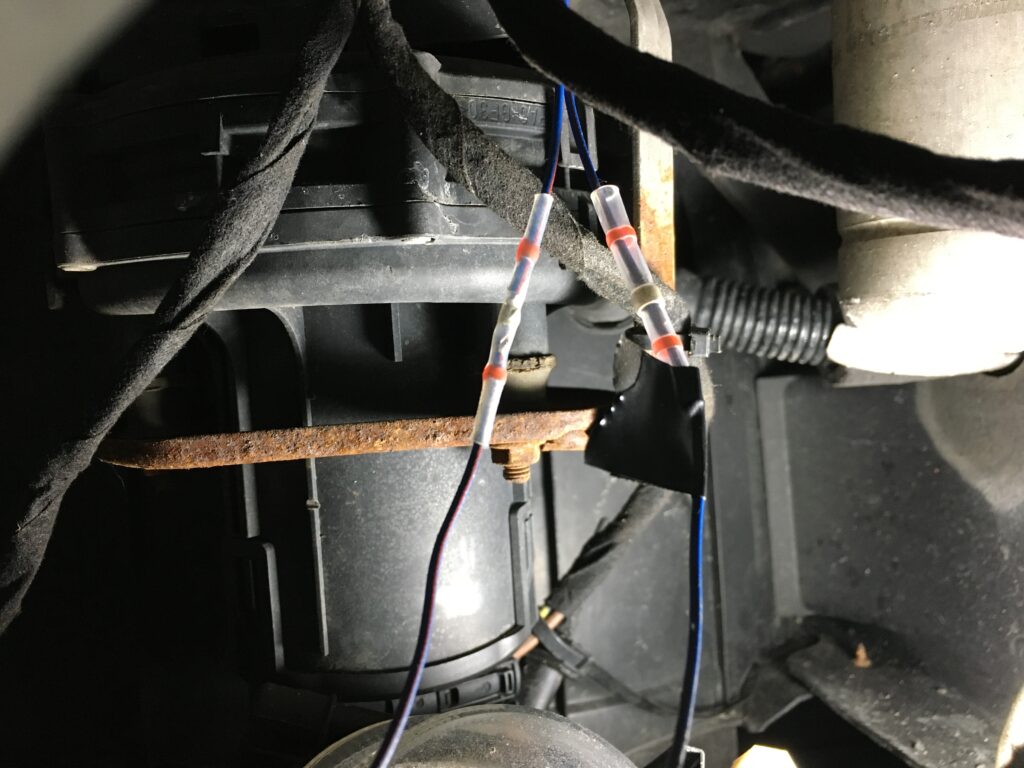
The connector on the left was already heat-shrunk.
I have some cloth wire-wrapping tape somewhere but couldn’t find it, so instead I used a section of generic plastic split wire loom to protect the repair.
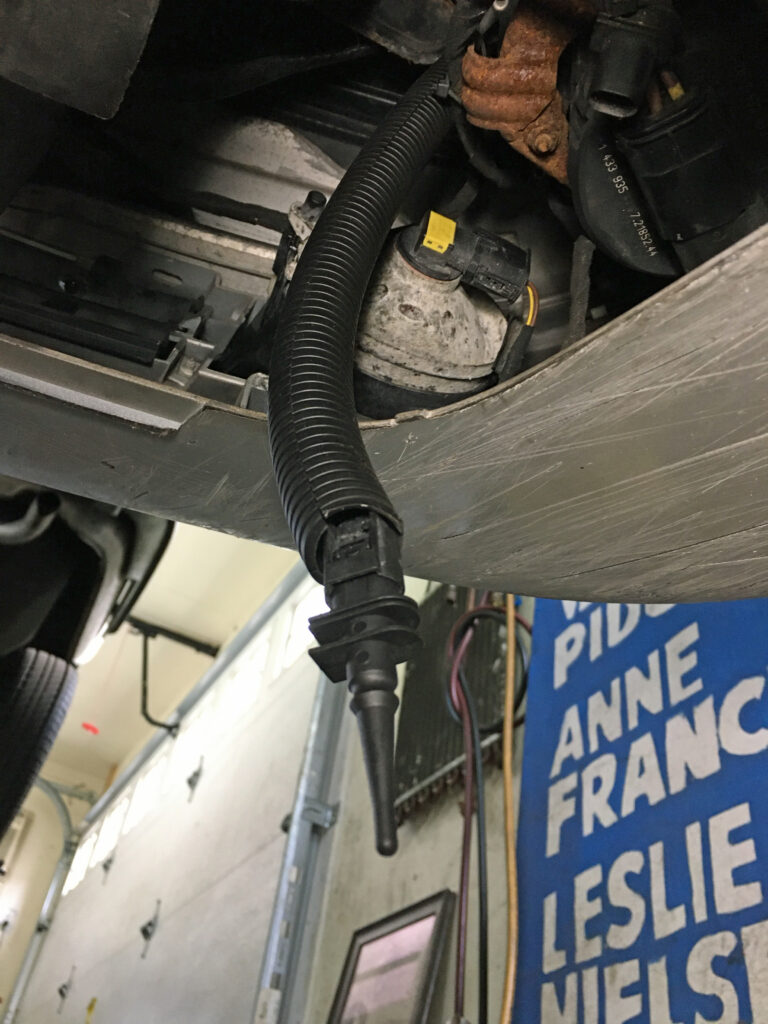
A bit clunky, but functional.
Lastly, I secured the sensor. The plastic loom made it difficult to re-attach it to the bracket for the intermediate air pump, so for now I zip-tied it to one of the air pump’s hoses.
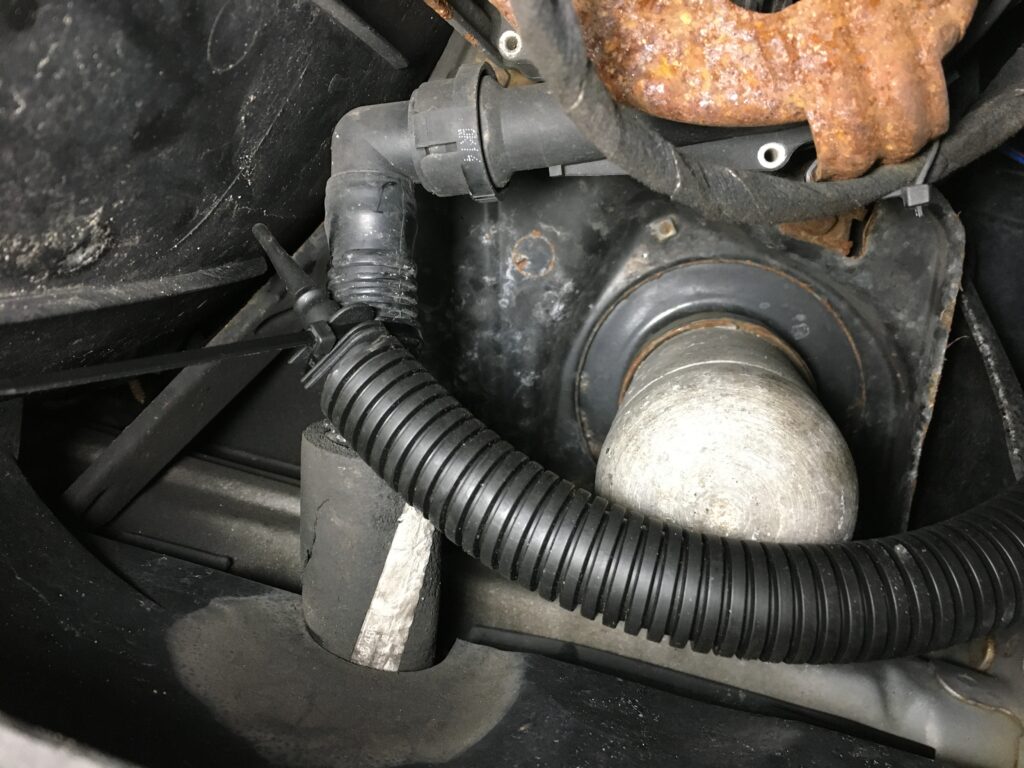
Done.
The repair that I thought I’d be in and out of in 15 minutes took about two hours (three if you count the hour it took to find the sensor that I didn’t really need), but it worked perfectly. I showered off the repair, then headed for Nashua to talk to the White Mountain CCA chapter, which was great fun. Onn the drive home, it poured rain, but the defrost in the car worked perfectly, turning on the a/c and keeping the windshield de-fogged.
And yes, even though I found and repaired a broken wire, I still installed the new but likely not needed $17 ambient temperature sensor. I mean, wouldn’t you?
—Rob Siegel
____________________________________
Rob’s newest book, The Best of The Hack Mechanic, is available here on Amazon, as are his seven other books. Signed copies can be ordered directly from Rob here.
Tags: Hack Mechanic Siegel Temperature Sensor
